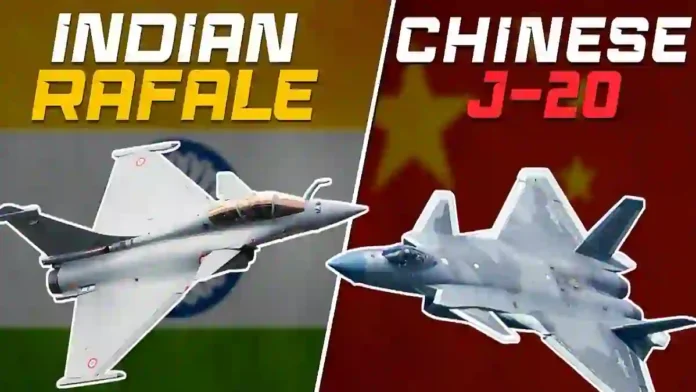Source – AFI
Chinese Air Force off late has been deploying its J-20 stealth fighter close to Indian border for last 3 years and increasing presence of the jet confirms that the PLAAF has been receiving large numbers of J-20 off late. IAF’s best bet is on the Dassault Rafale fighter jets when it comes to taking on J-20 stealth fighters. This analysis delves into the stealth features of the J-20 and Rafale and examines why the Rafale stands out as the best option for the Indian Air Force (IAF) until the indigenous Advanced Medium Combat Aircraft (AMCA) becomes operational
The Chengdu J-20, developed by China, is often classified as a fifth-generation stealth fighter. It incorporates advanced stealth technology to minimize its radar cross-section (RCS), making it difficult to detect and track.
The J-20’s airframe features smooth surfaces and sharp edges to deflect radar waves, reducing its radar signature. By housing weapons internally, the J-20 minimizes its RCS, avoiding the radar reflections caused by external weapon mounts. Extensive use of radar-absorbing materials further diminishes the J-20’s detectability The exact RCS of the J-20 is not publicly disclosed, but it is estimated to be significantly lower than that of non-stealth aircraft, potentially making it a formidable opponent in terms of stealth
The Dassault Rafale, a highly versatile French multirole fighter, also incorporates stealth features, although it is classified as a 4.5- generation fighter The Rafale’s design optimizes aerodynamics while incorporating measures to reduce its radar signature. The use of radar-absorbing materials on critical surfaces helps lower its RCS Estimates for the Rafale’s RCS range from 0.1 to 1 square meter, depending on its configuration and the specific measures taken to enhance its stealth capabilities While the Rafale’s stealth characteristics may not match those of a fifth-generation fighter like the J-20, its combination of stealth, agility, and advanced avionics makes it a formidable aircraft
The Rafale has proven itself in various combat scenarios, demonstrating exceptional versatility in air-to-air combat, ground attack, reconnaissance, and nuclear deterrence roles. Its multirole capability ensures that the IAF can deploy the Rafale in diverse mission profiles, providing a strategic advantage over single-role focused aircraft
The Rafale is equipped with state-of-the-art avionics, including the RBE2-AAAESA radar, which enharices its detection, tracking. and targeting capabilities. These advanced systems allow the Rafale to maintain situational awareness and engage threats effectively, even in contested environments.
The Rafale’s design allows for continuous upgrades, ensuring that it remains relevant in the face of evolving threats. The Rafale F4 variant, for instance, introduces enhancements in connectivity, radar, and weapons systems, further bolstering its combat effectiveness. The aircraft’s interoperability with existing and future IAF assets ensures seamless integration into India’s defense infrastructure
Unlike the J-20, which is still undergoing various stages of development and refinement, the Rafale is a mature platform with a well- established operational track record. The IAF’s ongoing induction and operational deployment of Rafale fighters ensure immediate and reliable enhancement of its air combat capabilities.
While the J-20’s stealth features present a significant challenge, the Rafale’s combination of Semi-stealth, versatility, and advanced technology positions it as the best interim solution for the IAF. The Rafale not only enhances India’s immediate combat capabilities but also bridges the gap until the indigenous AMCA program comes to fruition
As the AMCA project progresses, incorporating lessons learned from the Rafale’s operational deployment will be crucial. Until then the Rafale remains India’s most potent tool to counter the J-20 and maintain air superiority in a rapidly evolving strategic landscape
This report is auto-generated from a syndicated feed




